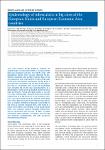Epidemiology of tuberculosis in big cities of the European Union and European Economic Area countries
Vries, G. de
Aldridge, R. W.
Caylà, J. A.
Haas, Walter
Sandgren, A.
Hest, N. A. van
Abubakar, I.
This cross-sectional survey aimed to examine the epidemiology of tuberculosis (TB) in European Union (EU) and European Economic Area (EEA) cities with populations greater than 500,000. National TB programme managers were asked to provide data on big city population size, total number of notified TB cases in big cities and national notification rate for 2009. A rate ratio was calculated using the big city TB notification rate as a numerator and country TB notification rate, excluding big city TB cases and population, as a denominator. Twenty of the 30 EU/EEA countries had at least one big city. Pooled rate ratios were 2.5, 1.0, and 0.7 in low-, intermediate- and high-incidence countries respectively. In 15 big cities, all in low-incidence countries, rate ratios were twice the national notification rate. These data illustrate the TB epidemiology transition, a situation whereby TB disease concentrates in big cities as national incidence falls, most likely as a result of the higher concentration of risk groups found there. This situation requires targeted interventions and we recommend that big city TB data, including information about patients’ risk factors, are collected and analysed systematically, and that successful interventions are shared.
No license information

